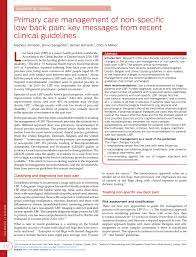Abstract
Objective: The aim of this study was to provide an overview of the recommendations regarding the diagnosis and treatment contained in current clinical practice guidelines for patients with non-specific low back pain in primary care. We also aimed to examine how recommendations have changed since our last overview in 2010.

Method: The searches for clinical practice guidelines were performed for the period from 2008 to 2017 in electronic databases. Guidelines including information regarding either the diagnosis or treatment of non-specific low back pain, and targeted at a multidisciplinary audience in the primary care setting, were considered eligible. We extracted data regarding recommendations for diagnosis and treatment, and methods for development of guidelines.
Results: We identified 15 clinical practice guidelines for the management of low back pain in primary care. For diagnosis of patients with non-specific low back pain, the clinical practice guidelines recommend history taking and physical examination to identify red flags, neurological testing to identify radicular syndrome, use of imaging if serious pathology is suspected (but discourage routine use), and assessment of psychosocial factors. For treatment of patients with acute low back pain, the guidelines recommend reassurance on the favourable prognosis and advice on returning to normal activities, avoiding bed rest, the use of nonsteroidal anti-inflammatory drugs (NSAIDs) and weak opioids for short periods. For treatment of patients with chronic low back pain, the guidelines recommend the use of NSAIDs and antidepressants, exercise therapy, and psychosocial interventions. In addition, referral to a specialist is recommended in case of suspicion of specific pathologies or radiculopathy or if there is no improvement after 4 weeks. While there were a few discrepancies across the current clinical practice guidelines, a substantial proportion of recommendations was consistently endorsed. In the current review, we identified some differences compared to the previous overview regarding the recommendations for assessment of psychosocial factors, the use of some medications (e.g., paracetamol) as well as an increasing amount of information regarding the types of exercise, mode of delivery, acupuncture, herbal medicines, and invasive treatments. These slides can be retrieved under Electronic Supplementary Material.
 Blog de Fisioterapia Fisioterapia
Blog de Fisioterapia Fisioterapia



